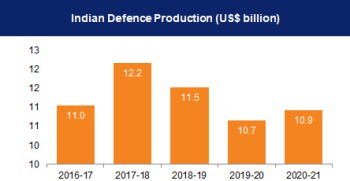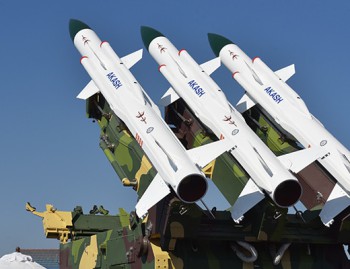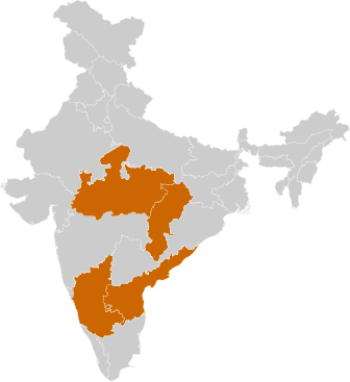INTRODUCTION
The Indian defence manufacturing industry is a significant sector for the economy. The industry is likely to accelerate with rising concerns of national security. Demand for defence equipment in India has been growing due to the ongoing territorial disputes with Pakistan and China over the ownership of the Northern State of Kashmir and the North Eastern State of Arunachal Pradesh, respectively.
Over the last five years, India has been ranked among the top importers of defence equipment to gain technological advantages over rival countries such as China and Pakistan. To modernise its armed forces and reduce dependency over external dependence for defence procurement, several initiatives have been taken by the government to encourage ‘Make in India’ activities via policy support initiatives.

MARKET SIZE

India’s defence manufacturing sector has been witnessing a CAGR of 3.9% between 2016 and 2020. The Indian government has set the defence production target at US$ 25.00 billion by 2025 (including US$ 5 billion from exports by 2025). Defence exports in India were estimated to be at US$ 1.29 billion in 2019-20. India’s defence import value stood at US$ 463 million for FY20 and is expected to be at US$ 469.5 million in FY21. Defence exports in the country witnessed strong growth in the last two years. India targets to export military hardware worth US$ 5 billion (Rs. 35,000 crore) in the next 5 years. As of 2019, India ranked 19th in the list of top defence exporters in the world by exporting defence products to 42 countries.
INVESTMENTS
Foreign Direct Investment (FDI) equity inflow in the defence sector for April 2000 - June 2021 stood at US$ 10.15 million (Rs. 61.52 crore) as per data released by the Department for Promotion of Industry and Internal Trade (DPIIT).
- In November 2021, Mr. Rajnath Singh, Minister for Defence, inaugurated the first private operationalised defence manufacturing facility in the Uttar Pradesh Defence Industrial Corridor (UPDIC), in Lucknow. The facility operated by Aerolloy Technologies — a wholly owned subsidiary of PTC industries — will manufacture parts for aircraft and helicopter engines, structural parts for aircrafts, drones and UAVs, submarines, ultra-light artillery guns, space launch vehicles and strategy systems.
- The Defence Research & Development Organisation (DRDO) and Indian Air Force (IAF) successfully flight tested two indigenously-developed smart anti-airfield weapons in November 2021.
- In November 2021, to demonstrate the growing India-Israeli technological cooperation, the Defence Research and Development Organisation (DRDO), India and Directorate of Defence Research and Development (DDR&D), Ministry of Defence, Israel, entered a Bilateral Innovation Agreement (BIA) to promote innovation and R&D in start-ups and MSMEs of both countries for development of dual use technologies.
- The 11th Defence Technology and Trade Initiative (DTTI) Group meeting between India and the United States (US) was held virtually on November 09, 2021. The aim of the DTTI Group is to focus on a bilateral defence trade relationship and create opportunities for co-production and development of defence equipment.
- In November 2021, the Indian Army signed an MoU with the Bhaskaracharya National Institute for Space Applications and Geo-Informatics (BISAG-N), Gandhinagar, Gujarat. This MoU will facilitate exchange of knowledge and collaboration for development of GIS and IT-based enterprise resource planning software, train content, telecast audio-visual content, research and knowledge partnerships, technical support and upgradation for resources.
- In October 2021, India signed contracts and cleared projects worth ~Rs. 54,000 crore (US$ 7.21 billion), in less than a month, to enhance military capability with locally produce weapons and systems, including transport planes, tanks, helicopters, airborne early warning systems and counter-drone weapons.
- In October 2021, India and the US at the 16th India-US Defence Policy Group (DPG) meeting in Washington DC, discussed the possibility of expanding their bilateral defence cooperation to new domains, including space, cybersecurity, artificial intelligence and counter drone technologies.
- On October 27, 2021, India successfully launched the surface-to-surface ballistic missile, Agni-5, from the APJ Abdul Kalam Island, Odisha. The missile has the capacity and range to strike targets up to 5,000 kilometres with a very high degree of accuracy.
- In October 2021, the Ministry of Defence signed a contract with the US Government, under Foreign Military Sale (FMS), for procurement of MK 54 torpedo and expendables (chaff and flares) for the Indian Navy, at a cost of Rs. 423 crore (US$ 56.53 million).
- The 12th edition of DefExpo, India’s flagship event showcasing land, naval, air and homeland security systems will be held in Gandhinagar, Gujarat, from March 10 to March 13, 2022. The aim of DefExpo-2022 is to build and achieve ‘Aatmanirbharta’ (self-reliance) in defence and increase defence exports to US$5 billion by 2024.
- In September 2021, the Ministry of Defence announced a Rs. 22,000 crore (US$ 3.0 billion) deal with Tata-Airbus to procure 56 C-295 transport aircraft for the Indian Air Force (IAF). This deal is part of a series of initiatives to advertise the non-public sector in defence manufacturing.
- In September 2021, India proposed to make the India-Africa Defence Dialogue a regular event by holding it alongside the DefExpo military exhibition held in every two years. The dialogue will help develop existing partnerships between African countries and India to explore new areas of convergence for mutual engagements including capacity building, training, cyber security, maritime security, and counterterrorism, according to a statement by the defence ministry.
- In September 2021, Defence Minister, Mr. Rajnath Singh, at the India-Australia 2+2 ministerial dialogue, said that both countries are exploring new areas in the fields of artificial intelligence and unmanned vehicles.
- In August 2021, Defence Minister, Mr. Rajnath Singh, approved the launch of Defence Testing Infrastructure Scheme (DTIS) with an outlay of Rs. 400 crore (US$ 54 million) to create state-of-the-art testing infrastructure and boost domestic defence & aerospace manufacturing.
- The five-year scheme is predicted to set up 6-8 new test facilities in partnership with private industries and facilitate indigenous defence production
- The projects under the scheme will be given up to 75% government funding in the form of ‘Grant-in-Aid’. The remaining 25% of the project cost will be borne by a Special Purpose Vehicle (SPV) comprising members from Indian private entities and state governments.
- In August 2021, a webinar and expo between India and Malaysia was held under the theme of ‘Indian Defence Industry Global Outreach for Collaborative Partnership’. The webinar was part of the series being organised with friendly foreign countries to boost defence exports to US$5 billion by 2024.
- In July 2021, the Ministry of Defence and the US Department of Defence signed a Project Agreement (PA) for Air-Launched Unmanned Aerial Vehicle (ALUAV), under the Joint Working Group Air Systems in the Defence Technology and Trade Initiative (DTTI). This agreement is a significant step towards deepening defence technology cooperation between the two countries.
- In June 2021, Defence Minister, Mr. Rajnath Singh, approved a proposal for the construction of six submarines at an estimated cost of ~ Rs. 43,000 crore (US$ 5.76 billion).
- To boost the Indian Government’s ‘self-reliant’ India initiative in June 2021, Defence Minister, Mr. Rajnath Singh, approved the budgetary funds worth Rs. 498.8 crore (US$ 66.83 million) to Innovations for Defence Excellence (iDEX), a Defence Innovation Organisation (DIO) for the next five years.
- The government is also inviting foreign players to invest in India and capitalise on the ‘Make in India’ opportunity. In June 2021, Defence Minister, Mr. Rajnath Singh, invited Swedish companies to invest in defence corridors in Uttar Pradesh and Tamil Nadu.
- On May 12, 2021, PM CARES Fund approved the procurement of 150,000 units of ‘Oxycare’—SpO2-based oxygen supply system developed by the Defence Research and Development Organisation (DRDO) at a cost of Rs. 322.5 crore (US$ 44.16 million).
- On May 17, 2021, the Defence Ministry unveiled the first batch of anti-COVID drug, 2-deoxy-D-glucose (2-DG) developed by the Institute of Nuclear Medicine and Allied Sciences (INMAS), a lab of Defence Research and Development Organisation (DRDO), along with Dr. Reddy’s Laboratories (DRL), Hyderabad.
- In April 2021, Under the Development cum Production Partner (DcPP) programme, Defence Research and Development Organisation (DRDO) allowed private sector firms to develop and produce missile systems, such as vertical launched surface and air missile system programmes, to promote the domestic defence industry.
- In April 2021, Defence Research and Development Organisation (DRDO) developed an advanced chaff technology to safeguard the naval ships against a missile attack. Defence Laboratory Jodhpur (DLJ), a DRDO laboratory, has indigenously developed three variants of this critical technology, namely short-range chaff rocket (SRCR), medium-range chaff rocket (MRCR) and long-range chaff rocket (LRCR) that meet Indian Navy’s qualitative requirements. This successful development of advanced chaff technology by DLJ is another step towards ‘Atmanirbhar Bharat’.
- In April 2021, Defence Research and Development Organisation (DRDO) Defence Materials and Stores Research lab and Development Establishment (DMSRDE), Kanpur, developed a lightweight bullet proof jacket (BPJ), which weighs 9.0 kilogrammes and meets qualitative requirements of the Indian Army.
- In April 2021, Defence Research and Development Organisation (DRDO) developed single crystal blades technology and supplied 60 of these blades to Hindustan Aeronautics Limited (HAL), as part of their indigenous helicopter development programme, for helicopter engine application.
GOVERNMENT INITIATIVES
In November 2021, Defence Acquisition Council (DAC) boosted the ‘Make in India’ initiative by according Acceptance of Necessity (AoN) — to capital acquisition proposals worth Rs. 7,965 crore (US$ 1.07 billion) — for modernisation and operational needs of armed forces.
The government has established two Defence Industrial Corridors (DICs) in the country, one in Uttar Pradesh called the Uttar Pradesh Defence Industrial Corridor (UPDIC) and the other in Tamil Nadu called the Tamil Nadu Defence Industrial Corridor (TNDIC), with the goal of attracting Rs 10,000 crore (US$ 1.31 billion) in investment in each.
On October 15, 2021, Prime Minister, Mr. Narendra Modi, dedicated the seven defence public sector undertakings (PSUs)—created through the restructuring of the Ordnance Factory Board (OFB)—to improve functional autonomy, efficiency, growth potential and innovation in the defence sector.
Government formulated the ‘Defence Production and Export Promotion Policy 2020’ to provide impetus to self-reliance in defence manufacturing under the ‘Aatmanirbhar Bharat’ scheme. The ministry aims to achieve a turnover of Rs. 1 lakh 75 thousand crore (US$ 25 billion), including an export of Rs. 35 thousand crore (US$ 5 billion) in the aerospace and defence goods and services by 2025.
To encourage more participation from start-ups and micro, small & medium enterprises (MSMEs) in Defence Research & Development (R&D) in achieving the ‘Aatmanirbhar Bharat’ goal, the Defence Minister Mr. Rajnath Singh released a new version of ‘Defence Research and Development Organisation (DRDO) Procurement Manual 2020’ on October 20, 2020. There are plans to establish new infrastructure including a defence park in Kerala to manufacture defence equipment for the armed forces. The project is aimed at promoting MSMEs and boosting the ‘Make in India’ initiative. In November 2020, the Department of Defence, in partnership with the DGDE and Armed Forces, established a land management system (LMS) as part of efforts to enhance the overall defence land management. In February 2021, Defence Research and Development Organisation (DRDO) handed over Licensing Agreements for ToT (LAToT) for 14 DRDO developed technologies to 20 industries at Aero India 2021 in Bengaluru.
To increase defence manufacturing in India and make the country a reliable weapon supplier to friendly countries, the Indian government allowed the following FDI limits in September 2020. For new licensees - FDI allowed up to 74% through automatic route; FDI beyond 74% would need to be permitted under the Govt. route. For existing Licensees - Infusion of new foreign investments up to 49% can be added by making declarations of change/transfer within 30 days.
Defence ministry plans to put 101 defence items (artillery guns and assault rifles) under import embargo to offer potential military hardware manufacturing opportunities to the Indian defence industry. In February 2020, Defence Minister Mr. Rajnath Singh at Aero India 2021 announced to reduce defence imports by at least US$ 2 billion by 2022.
The defence ministry estimates potential contract worth ~Rs. 4 lakh crore (US$ 57.2 billion) for the domestic industry in the next 5-7 years (2025-2027). To boost the domestic defence sector manufacturing, the Ministry of Defence, in December 2020, approved the export of indigenously-developed surface-to-air Akash missile system and set up a panel to ensure faster approvals for acquisition proposals by various countries.
ROAD AHEAD
The Indian government is focussing on innovative solutions to empower the country’s defence and security via ‘Innovations for Defence Excellence (iDEX)’, which has provided a platform for start-ups to connect to the defence establishments and develop new technologies/products in the next five years (2021-2026).
Working through partner incubators, iDEX has been able to attract the start-up community to participate in the Defence India Start-up Challenge (DISC) programme.
The Defence Ministry has set a target of 70% self-reliance in weaponry by 2027, creating huge prospects for industry players. Introduced Green Channel Status Policy (GCS) to promote and encourage private sector investments in defence production to promote the role of private sector in defence production.

References: Ministry of Defence, Government of India, Defence Reports, Press Releases, Press Information Bureau, Department for Promotion of Industry and Internal Trade (DPIIT), Hindustan Times, Defence News, Financial Express
Note:Conversion rate used for November 2021 is Rs. 1 = US$ 0.01336
Disclaimer: This information has been collected through secondary research and IBEF is not responsible for any errors in the same.
Defence Clusters
- Karnataka
- Andhra Pradesh
- Madhya Pradesh
- Chhattisgarh

Industry Contacts
- Defence Research and Development Organisation (DRDO)
- The Society of Indian Defence Manufacturers (SIDM)
- Defense & Strategic Industries Association of India